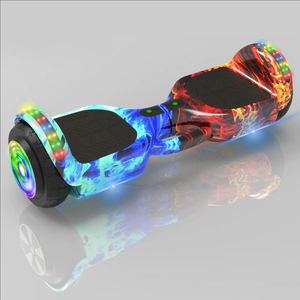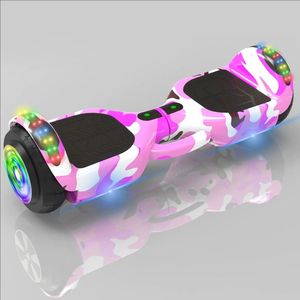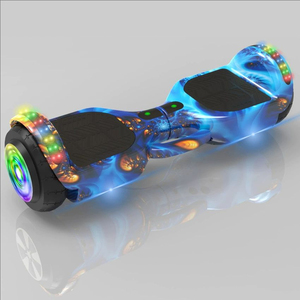
All categories
Featured selections
Trade Assurance
Buyer Central
Help Center
Get the app
Become a supplier

(1254 products available)





































The hoverboard for kids is self-balancing and fun to use, making it an excellent choice for young riders. These boards come in different types and designs. There is the Bluetooth-enabled hoverboard, which is a popular choice among kids. It allows them to listen to music while riding. It has built-in speakers and connects to devices via Bluetooth. The speaker's sound quality is good, with a decent bass and treble balance. Some boards have LED lights, which make riding at night or in low-light conditions safer. The lights also add a fun element to the riding experience. Another option is the off-road hoverboard. It features rugged wheels measuring up to 8.5 inches. This makes it suitable for uneven surfaces like grass, gravel, or dirt. The board has a high weight capacity, which makes it ideal for older kids and teenagers. It can easily handle the extra weight without compromising performance. The self-balancing hoverboard is designed with beginners in mind. It has a self-balancing feature that helps kids maintain stability when riding for the first time. The learning curve is shorter, and kids quickly adapt to using the board. Once they get used to it, they can upgrade to other models that offer higher speeds and performance.
Another type is the racing hoverboard. It has a high top speed of up to 12 km/h or more. The powerful motors and lithium-ion batteries improve performance and speed. Some boards also have a high climbing capacity, which allows them to climb inclines of up to 15 degrees or more. A hoverboard with a smart app is a tech-savvy option. The app has features that help monitor the board's speed, battery life, and performance metrics. Some boards even have GPS tracking, which helps locate the board in case it gets lost or stolen.
Kids' hoverboards have a broad appeal and can be used in several ways. Some of the common usage scenarios include:
Recreational Riding
This is the primary purpose of a hoverboard. Kids use it for fun and play. The boards offer a thrilling and enjoyable experience when used for casual riding. They are ideal for activities like cruising around the neighborhood, parks, or other places offering open spaces.
Commuting to School
Parents do not need to carry their children when going to school in a car. Instead, they can use a hoverboard to make this daily routine more exciting. It can be used to commute short distances to and from school. However, it is vital to check the local laws and regulations to ensure that riding a hoverboard is permitted on public sidewalks or paths.
Neighborhood Exploration
Kids can explore their neighborhoods with friends. They can visit nearby parks, friends' houses, or local attractions using a hoverboard. This can help them develop a sense of independence and confidence while remaining within safe and supervised areas.
Indoor Use
Some hoverboards come with protective pads and are small in size, making them suitable for use in large indoor spaces. Kids can ride their boards in basements, large garages, or empty warehouses.
Skill Development
Riding a hoverboard requires balance and coordination. These skills are essential for other activities and sports. Therefore, kids can use the board to refine their balancing skills. This is particularly useful for children who participate in sports like skateboarding, snowboarding, or even gymnastics.
Hoverboard Games and Challenges
Kids can organize games and challenges with friends. They can set up obstacle courses, race each other, or try balance-based games. This adds a competitive and social element to their hoverboard rides. Additionally, it encourages physical activity.
Fitness and Exercise
Using a hoverboard is a fun way for kids to engage in physical activity and exercise. This is particularly useful for children who enjoy outdoor activities. It helps them stay active, improve their cardiovascular health, and have fun simultaneously.
Before purchasing a hoverboard, it is important to consider its suitability for the intended user. Parents should examine the factors that determine how appropriate a board is for a child and whether it is safe for their use.
The first and most important thing is to check the age range that the manufacturer recommends for the user. It is necessary to ensure that the board is suitable for the child's age, as this will help determine whether it is safe and appropriate for them. In turn, this will assist parents in avoiding boards that may be too difficult or dangerous for a child to use or boards that may not be fun or comfortable for a child.
Another important factor to consider is the weight capacity of the hoverboard. Parents need to check how much weight it can carry to ensure that their child fits within the required limit. They should also take note of any additional features or accessories they may want to carry along so that they do not exceed the maximum load.
Lastly, it is necessary to take into account the overall size of the board. In this case, it is important to look for a model that is not too big or small, as either of them will make it difficult for a child to control or store the board. Therefore, hoverboards with self-balancing features are the best choice because they can adjust to the rider's weight.
Below are the features, functions, and design of a hoverboard:
LED lights
Hoverboards for children frequently include LED lights. These lights improve visibility in low-light settings and make riding more enjoyable. Additionally, the hoverboard's wheels may include LED lights that illuminate the ground as the rider moves, producing a captivating visual effect.
Bluetooth speakers
Many hoverboards come with built-in Bluetooth speakers. This feature allows kids to listen to music or audiobooks while riding, enhancing their overall experience. The speakers are usually of good quality, providing clear sound without disturbing others.
App connectivity
Some high-tech hoverboards offer app connectivity. Through these apps, parents can monitor their child's riding speed and habits, set speed limits, and track the hoverboard's battery life. The app can also provide diagnostic information and suggest maintenance tips.
Adjustable speed settings
Hoverboards for kids often feature adjustable speed settings. This allows parents to set a maximum speed limit suitable for their child's age and skill level. As the child becomes more experienced, the speed limit can be adjusted upwards.
Durable construction
Kids' hoverboards are built to be durable. They often have a sturdy frame made from materials like ABS plastic or aluminum, which can withstand rough usage. This durability ensures the hoverboard has a long lifespan and requires minimal maintenance.
All-terrain capability
Some hoverboards are designed for all-terrain use. They have larger wheels with deep treads, providing better grip on uneven surfaces like grass, gravel, or sand. All-terrain hoverboards are versatile and can be used in various environments.
Safety certification
To ensure safety, well-made hoverboards for kids often come with various certifications. These boards meet specific safety standards and undergo rigorous testing to ensure reliability. Purchasing a certified hoverboard provides peace of mind knowing it has been deemed safe for use.
Color and design variety
Hoverboards come in various colors and designs. This feature allows kids to choose a hoverboard that matches their style or favorite colors. Whether it's a bright pink board with glitter or a sleek black hoverboard with blue accents, the personalization aspect makes riding more enjoyable for kids.
Q1: How does a hoverboard for kids work?
A1: A hoverboard's mechanism involves a gyroscope and sensors to maintain balance. It uses a rechargeable battery and electric motors in the wheels. To ride it, one shifts their weight in the desired direction, and it moves accordingly.
Q2: What age is appropriate for a hoverboard?
A2: Generally, hoverboards are recommended for children aged 8 years and above. Nonetheless, the suitable age may differ depending on the model and manufacturer's specifications. It is also dependent on the child's ability to follow safety precautions and ride the gadget appropriately.
Q3: Are hoverboards safe for children?
A3: Ideally, a hoverboard's safety for children is contingent upon various factors, including its quality, speed specifications, and the child's age and riding proficiency. In addition, the presence of safety features such as LED lights, non-slip pedals, and beginner modes enhances its safety.
Q4: Can a 5-year-old use a hoverboard?
A4: While there is no age limit for using a hoverboard, most manufacturers recommend it for children above 8 years. Nonetheless, some models accept younger children as long as they are supervised by an adult when riding.
Q5: What features should one look for in a hoverboard for kids?
A5: When purchasing a hoverboard, some features to look for include non-slip pedals, LED lights, a sturdy frame, and a reliable battery. In addition, consider a model with beginner modes and safety gear such as wrist guards, helmets, and knee pads.